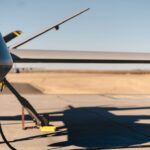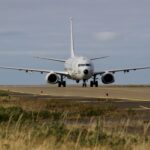The U.S. Navy and Raytheon, an RTX business, have completed the first live maritime test of the AN/SPY-6(V)4 radar at the Pacific Missile Range Facility, Barking Sands, Hawaii. The event produced real world data on air and surface target tracks and confirmed that the (V)4 configuration meets key performance goals outside the lab. The series took place over open water with varied target sets and environmental conditions, including sea clutter and multi-target presentations that stress discrimination logic.
Raytheon says the run generated the first live data set for the (V)4 baseline. Engineers will use that data to tune waveforms, refine resource managment and validate simulation models before shipboard integration. A short statement from Barbara Borgonovi, president of Naval Power at Raytheon, framed the result as “a major step forward” for fleet capability. Defense officials confirm the test focused on tracking quality and stability across look angles rather than headline range claims.
First live maritime test at Pacific Missile Range Facility validates SPY-6(V)4 tracking
Navy range controllers ran a series of air and surface presentations to measure track initiation time, continuity and false-alarm rates. Industry sources said the target set combined fast moving air tracks and small radar cross-section (RCS) surface contacts to stress performance in sea clutter. Run cards mirrored earlier modeling and simulation profiles to allow one-to-one comparisons. Program officials reported stable track purity and consistant update rates across this first at-sea series.
The team used PMRF’s Advanced Radar Detection Laboratory at the Pacific Missile Range Facility to enable long dwell times and clean separation between runs. Range instrumentation provided ground-truth data for post-test reconciliation and to validate model fidelity.
Navy and Raytheon analysts have moved into data exploitation, correlating recorded tracks with radar-resource logs to refine scheduling and side-lobe control.
Follow-on events will widen the target set and introduce more complex multipath environments to further stress processing, calibration and tracking modes.
AN/SPY-6(V)4 architecture
SPY-6(V)4 uses four fixed arrays with 24 Radar Modular Assemblies (RMAs) per face, built from the same blocks used across the SPY-6 family. Flight III destroyers field the larger SPY-6(V)1 with 37 RMAs per face, but software and back end processing remain common. The shared baseline cuts spares and keeps variants on the same software drop. The (V)4 is slated to integrate with Aegis Baseline 10 on Flight IIA destroyers.
The backfit focuses on better sensitivity against low-altitude threats, stronger clutter supression in heavy seas, and higher track capacity under saturation raids. Active arrays enable rapid beam steering and adaptive waveform control without the inertia limits of mechanically steered systems. Resource managment software allocates dwell time and frequency diversity by sector and threat priority while preserving volume search. These functions were exercised at PMRF and will be updated as analysts work through the new dataset.
DDG MOD 2.0 rollout – Flight IIA backfit timeline, USS Sterett and USS Pinckney plans
The U.S. Navy’s “Destroyer Modernization 2.0″ package adds four upgrades to selected Flight IIA Arleigh Burke destroyers: Aegis Baseline 10, the AN/SLQ-32(V)7 SEWIP Block 3 suite, the SPY-6(V)4 radar and high-efficiency chillers to manage added thermal loads from the radar and EW systems. The Navy has identified initial hulls and will phase installations to manage risk across the force.
USS Sterett (DDG-104) is slated to be the first ship to receive the full set in a single availability. In parallel, USS Pinckney (DDG-91) has completed the SEWIP Block 3 backfit and is scheduled to enter the broader modernization window in 2026, with return to service in 2028. The sequence follows a “smart start” approach: field EW first on selected hulls, then add SPY-6(V)4 and Baseline 10 in a follow on period.
Program managers are prioritizing schedule discipline and yard capacity over rapid, fleet wide installation.
The Navy expects more than 60 ships to operate SPY-6 family radars over the next decade when combining Flight III deliveries with Flight IIA backfits. Common radar and combat-system software supports shared training and sustainment while scaling sensor capacity to mission needs.
What the data shows from the (V)4 open-water run and why it matters for fleet ops
Range events measured how quickly the radar promoted tentative plots to firm tracks and how well it maintained track quality as targets manuevered or crossed sectors. Test reports cite steady continuity across aspect changes and consistent performance in mixed clutter. The team also recorded sidelobe behavior and out-of-beam energy to refine calibration on future builds. Defense officials said the event exercised electronic protection modes to assess resilience under low-level interference.
Initial analysis centers on reaction time and saturation control. Flight IIA destroyers with SPY-1D(V) face capacity limits when multiple axes present threats at once. The (V)4, though smaller than the Flight III array, delivers higher sensitivity, faster update rates, and more flexible resource schedueling. That combination raises track quality sooner and holds it longer, supporting tighter fire control solutions and more efficient interceptor allocation. Senior officers involved in ship integration said the backfit is intended to compress the detect-to-engage timeline without imposing excessive power or cooling demand on the hull.
Test observers highlighted three outcomes relevant to deployment workups:
- Earlier firm tracks on low-altitude air threats support more confident doctrine selection inside the combat system.
- Stable surface tracks in heavy sea states lower operator workload when small contacts crowd the display.
- Cleaner handoff to Aegis fire control supports tighter shot doctrine and fewer re-engagements under stress.
These points align with the Navy’s push for survivablity through sensing improvements rather than wholesale platform changes.
The shipfit remains demanding. Crews will adapt to a different human-machine-interface tempo; combat-system watch teams will rewrite local procedures, and maintenance departments will take on new built-in-test regimes for arrays and T/R modules. Yard periods must handle structural work around array foundations and cable runs while keeping room for other depot task. Program staff said those constraints drove the decision to stagger upgrades across hulls and avoid bottlenecks at a few regional yards.
The Hawaii event did not run ballistic missile defense raid profiles or the full set of electronic attack conditions. Those trials follow after model validation on this first data set. The approach relies on software concurrence across SPY-6 variants to spiral capability without frequent hardware swaps on Flight IIA ships. The common RMA architecture underwrites that plan and should shorten the path from code release to operational benfit on platforms already fielding SPY-6.
Barbara Borgonovi called the live demo “a major step forward” and emphasized support for allied operations. Next steps are to continue at-sea trials, add heavier stress cases and move to full installation on lead backfit hulls as software hardens. The radar is framed as a core element of the destroyer life-extension plan and a bridge to next generation sensors and combat systems.
REFERENCE SOURCES
- https://www.barchart.com/story/news/34389779/rtx-s-raytheon-successfully-demonstrates-advanced-tracking-capabilities-of-an-spy-6v4-radar
- https://www.rtx.com/news/news-center/2025/08/26/rtxs-raytheon-successfully-demonstrates-advanced-tracking-capabilities-of-an-spy
- https://www.prnewswire.com/news-releases/rtxs-raytheon-successfully-demonstrates-advanced-tracking-capabilities-of-anspy-6v4-radar-302537909.html
- https://www.navalnews.com/naval-news/2025/08/rtx-successfully-demonstrates-advanced-tracking-capabilities-of-an-spy-6v4-radar/
- https://news.usni.org/2025/01/16/navy-identifies-first-destroyer-to-receive-full-set-of-ddg-mod-2-0-upgrades
- https://breakingdefense.com/2024/01/navy-taps-first-4-destroyers-for-initial-upgrades-to-radar-ew-combat-system/
- https://militaryembedded.com/radar-ew/test/anspy-6v4-radar-completes-first-live-maritime-test-at-pacific-missile-range-facility
- https://news.usni.org/2024/01/19/navy-refining-plan-for-its-17b-destroyer-electronic-warfare-backfit-with-4-test-ships



